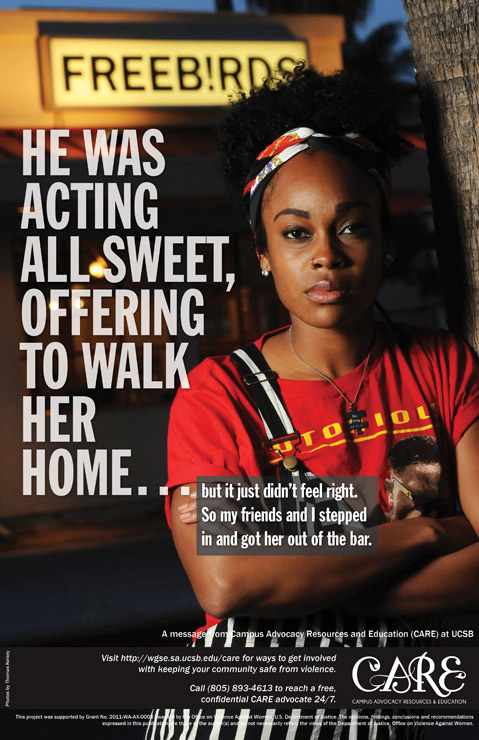Sexual Assault Facts
Campus Culture Must Switch to Prevention
An annual crime report released by UC Santa Barbara recently showed the number of forcible sexual assaults almost doubled over the previous year. According to the Clery Act Campus Security Report, there were 23 reported instances of forcible assault on campus in 2013, in contrast to 12 in 2012. These numbers, however, are just the tip of the iceberg.
UCSB’s Campus Advocacy Resources and Education (CARE), which educates students about sexual assault and provides support for victims, highlights several facts on its website. First, an American is assaulted every two minutes; second, one in four college women will be a victim of sexual assault during her academic career.
In an online article published by U.S. News & World Report, UCSB was said to serve 19,362 students, 52 percent of whom are female. If you do the math, you will see that this translates to about 2,500 women being sexually assaulted during their time at the university. Without a way to gauge how many women are choosing not to report sexual assaults, it’s impossible to come up with an exact figure; however, whether this number is in the thousands or in the hundreds, it’s obvious that more needs to be done to prevent the crime from occurring.
You may ask yourself why there were only 23 forcible rapes reported in 2013 when the actual number of sexual assaults seems to be so much higher? The Rape, Abuse & National Network says that as many as 60 percent of rapes go unreported to police. There are many reasons people decide not to report. They might want to forget an assault had ever happened, feel that somehow they had brought it on themselves, be humiliated, or sense that authorities would not give them the support they need.
What If You Didn’t Feel That Justice Would Be Served?
Myra Crimmel, a former UCSB student who reported a sexual assault to university officials in 2013, eventually filed a complaint with the U.S. Department of Education a year later. She alleged that UCSB had not conducted a thorough investigation into her allegations, did not mete out a fair punishment, and that this constituted a hostile environment in which students wouldn’t feel free to report crimes. Crimmel said that one of her attackers was suspended from school, but when he returned, he ended up in one of her classes. Not something anyone would want. And she was not the only one who has filed complaints. There are other students at UCSB and across the country who have filed similar complaints.

Educating Everyone About Assault
Education is key to creating a campus culture that doesn’t condone sexual assaults. CARE has a number of pictures on its website with clever captions that identify the types of attitudes that lead to sexual assault — and suggestions for safer outcomes. Women who left their friend at a party: “A dude was hanging all over her, so we took off” … and got her to leave with us”; another one with a man saying, “She was on her own, so I made my move … and told the guys hassling her to back off.”
Each of these examples shows the ways that our distorted view of who is responsible creates the wrong community culture. CARE runs workshops and trainings that help students learn how to recognize the warning signs and extricate someone from a difficult situation. They also help people understand more about sexual assault so that they can help prevent themselves from being a victim or a perpetrator.
However, there is a key piece that also needs to be addressed. People need to have a clear idea of what rape is. Ads on television state that “‘no’ means no,” and rape counselors will tell you that an assault occurs anytime a woman or man does not give their consent to a sexual act. Even if both individuals are drunk, this rule still stands. However, even intelligent people, can find themselves questioning what a sexual assault actually is.
I listened to an interview on NPR with Lena Dunham who created HBO’s show Girls and has written a book of essays, Not That Kind of Girl. Dunham talked about being raped in college and the effect it had on her life. She said she didn’t view it as a rape when it first happened. Her friend did, and named it as such, but she didn’t. She said that after the assault she stopped going to parties, drinking, and completely changed her behavior. It took her awhile to recognize what had happened. Later on, she felt grateful that her friend had labeled the act for what it was, validating the feelings of loss she was having.
What Now
While there have been many improvements made to reduce the number of sexual assaults, a lot remains to be done. Women have to feel confident that the authorities will take appropriate action once they come forward. In addition, the community needs to work on creating an atmosphere in which everyone is responsible, not only for their own behavior, but for trying to promote an environment in which sexual assault is not a commonplace occurrence and will not be tolerated or condoned.



